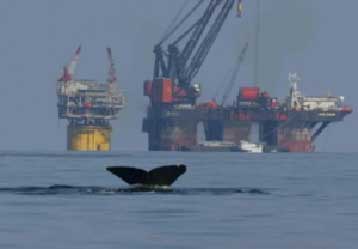- Welcome to Conscious Breath Adventures
A Crude Awakening - Swim with whales, Silver Bank Dominican Republic | Conscious Breath Adventures
- Home
- Conservation
- A Crude Awakening
Infamous as Moby Dick and also known as the cachalot (who was, ironically, caught a lot), is the sperm whale, Physeter macrocephalis. They are the largest of the world’s toothed whales, have the biggest brain in the animal kingdom and can dive to nearly two miles. In short, they are really cool! Life is not so cool right now though for a resident population, numbering around 140, just off the mouth of the Mississippi, where crude oil has been gushing into the Gulf of Mexico from a pipe ruptured when the Deepwater Horizon rig exploded on April 26th, 2010. As Gulf States prepare for clean up activities on-shore and commence the census of shorebirds, turtles, fish, dolphins, invertebrates and plant communities lost; we consider the sperm whale.
Their elusive, deep water nature means there is a lot we still don’t know. Recently, scientists confirmed that whales in the northern Gulf were genetically and vocally distinct from other sperm whales. They are slightly smaller and form smaller social groups. These whales are unique! They take advantage of the pelagic food chain bonanza which spins off the rich waters pouring from the Mississippi, and deep nutrient pulses which spiral up from the depths here, at a narrow zone in the Outer Continental Shelf. Their turf is also, as we now painfully know; prime real estate in the petroleum business.
Oil and marine mammals do not mix. Both the oil and especially the dispersants, contain persistent toxic chemicals that get dangerously concentrated higher up the food chain. Research on dolphins showed that they can identify and swim away from heavy oil, but not a light sheen: about 4,000 square miles of cetacean habitat in the Gulf is affected. Noxious fumes from the volatile, light fraction of crude oil will be concentrated at the sea surface, and so in every breath.
The incident brings to the fore bigger issues associated with our thirst for oil. Drilling activities, and the omnipresent search for new deposits, converge in the sperm whale’s deep water habitat. Like most cetaceans, sperm whales navigate, feed and communicate using sound. It is cruelly coincidental that we crudely copy their skill; hammering the seabed with pulses of sound waves to pick up the characteristic echo of oil. The impact of this round-the-clock seismic exploration has been the focus of long term studies to determine the effects on whales. The clicks and buzzes as a whale locates a soft bodied fish or squid must surely be drowned out by us blasting through 5,000 feet of water deep into solid rock. Sound has been implicated in strandings, hearing loss and tissue damage.
In 2008 a synthesis of six years of study on the impacts of seismic exploration on sperm whales was published by the Minerals Management Service. Six years, 15 authors, 345 pages and 9 million dollars and the results? Inconclusive. Is this a joke, perhaps you ask? Not at all. They did find out a lot about our whales, but this industry-funded piece stated that they needed more research in order to give any definitive conclusions.

Which begs the critical question – why is the fox guarding the henhouse? The Minerals Management Service (U.S. Department of the Interior) grants permits to oil companies to drill. They are also responsible for ensuring the activities are safe and to do so, dish out donations from oil companies to various universities to carry out the research. So the outlook for sperm whales and other marine mammals in the Gulf of Mexico is, fundamentally, at the mercy of what’s in the best interests of the oil industry.
At least one U.S. senator, Bill Nelson, D-Fla, has, in the wake of the Deepwater Horizon incident, called for an investigation into the extent to which the oil industry has influenced the agency’s rulemaking process. Two former directors of the agency have moved smoothly into leadership positions at an organization called the National Oceans Industries Association. Its mission; “to secure reliable access and a favorable regulatory and economic environment for the companies that develop the nation’s valuable offshore energy resources.”
For sperm whales and countless species in the northern Gulf of Mexico it might sadly be too late. For the rest of us, let’s hope it’s a wake up call.
Key Facts:
- 28 species of cetaceans occur in the Gulf of Mexico, along with the West Indian Manatee.
- All are protected by the Marine Mammal Protection Act.
- Seven species, including the sperm whale, are further protected by the Endangered Species Act.
- There are thought to be around 1,665 sperm whales throughout the Gulf of Mexico.
- Very little is known about their deep water prey, which includes the giant squid.
- Males average 35 feet long, females 28 feet. Elsewhere males can reach 67 feet in length.
- They can live over 70 years.
- Social structures are complex: historically they were targeted by whalers because of their habit of forming protective rings around calves.
- About 4,000 oil rigs dot the northern Gulf with 30 or so of them in depths of 5,000 of water.